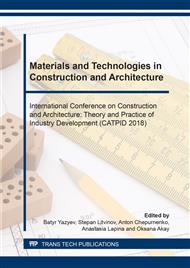[1]
V.S. Komarov, Factors determining the affordability of housing for the population, Science Review. 21 (2015) 218-220.
Google Scholar
[2]
L.G. Selyutina, Yu.N. Kuponosova, Solving the housing problem in Russia on the basis of modernizing large-panel housing construction, Privolzhsky Scientific Bulletin. 5 (57) (2016) 111-113.
Google Scholar
[3]
V.S. Belyaev, Т.А. Akhmyarov, Energy efficiency of large-panel buildings, Housing construction. 4 (2013) 47–49.
Google Scholar
[4]
N.A. Strakhova, P.A. Lebedinsky, Analysis of the Energy Efficiency of the Russian Economy, Engineering journal of Don, Rostov-on-Don, (2012).
Google Scholar
[5]
M.I. Bzhakhov, L.T. Kardanov, M.A. Kuchukov, E.A. Antipova, A.Kh. Lyuyev. Increase of thermal protection properties of the outer enclosing structure of a residential building of a typical series, Engineering journal of Don. 2 (2016) 142-153.
Google Scholar
[6]
N.I. Karpenko, V.N. Yarmakovskiy, The main areas of resource and energy conservation in the construction and operation of buildings. Part 1. Resource saving at the stage of production of building materials, wall products and enclosing structures, Building Materials, Moscow. 7 (2013).
Google Scholar
[7]
S.V. Szokolay, Environmental science handbook for architects and builders, Construction Press, Lancaster, (1980).
Google Scholar
[8]
GOST 25820-2014. Light concretes. Technical conditions.
Google Scholar
[9]
M. A. Ahmatov, Lightweight concretes and reinforced concrete structures on aggregates from stone waste and loose porous rocks, KBSAA, Nalchik, (2010).
Google Scholar
[10]
G.V. Nesvetaev, Concrete: study guide, Phoenix, Rostov-on-Don, (2011).
Google Scholar
[11]
I.A. Ivanov, Technology of lightweight concrete on artificial porous aggregates, Stroiizdat, Moscow, (1974).
Google Scholar
[12]
A.N. Davydyuk, Light structural and thermal insulating concretes on vitreous pore fillers, Redstar, Moscow, (2008).
Google Scholar
[13]
V.G. Dovzhik Calculation and normalization of thermal conductivity of claydite concrete and other types of concretes, reinforced concrete. 5 (2007) 15-19.
Google Scholar
[14]
S. Kosmatka, B. Kerkoff, R. Hooton, Designand control of Concrete Mixtures. The Guideto Application, Method sand Materials, Eight Canadian Edition. Cement Association of Canada, (2011).
Google Scholar
[15]
N.N. Grishin, OA Belogurova, A.G. Ivanova, Experimental-theoretical study of thermal conductivity and its effect on the thermal stability of forsterite refractories, Fire resisting and technical ceramic. 12 (2003) 4-15.
Google Scholar


